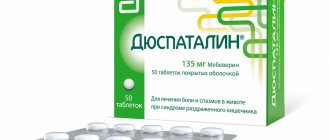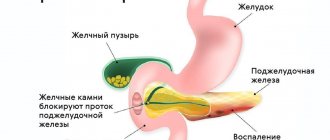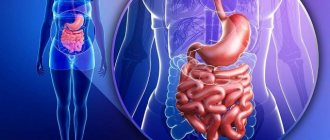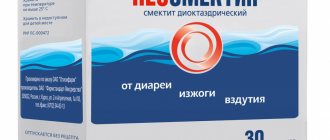Antacids
Antacids
(from Greek ἀντἰ- - against, Latin
acidus
- sour) - medications whose mechanism of action is based on the chemical neutralization of gastric acid.
Composition of antacids
The main acid-neutralizing active ingredients of modern antacids are magnesium, aluminum and calcium compounds.
Many of the modern antacid drugs, in addition, contain components that affect the gastrointestinal tract in a way other than neutralizing the acid: laxatives, carminatives, antispasmodics, anesthetics and others. Most modern antacid preparations use a balanced combination of magnesium compounds (magnesium oxide, magnesium hydroxide, magnesium peroxide, magnesium carbonate) and aluminum (aluminum hydroxide, aluminum phosphate and others). Such antacid drugs are characterized by a slower onset of therapeutic effect compared to sodium and calcium compounds, but they have a longer effect time. Such compounds do not dissolve in water, are practically not absorbed into the blood, are characterized by antipeptic properties and partially adsorb toxins. Aluminum compounds help slow intestinal motility and in large quantities can cause constipation, while magnesium compounds accelerate intestinal motility and have a laxative effect. Aluminum compounds enhance the synthesis of prostaglandins, promote the formation of a protective film on the surface of damaged tissues, adsorb bile acids and lysolecithin, and increase the tone of the lower esophageal sphincter. Magnesium compounds increase mucus formation and resistance of the gastric mucosa. The table below (Kharchenko N.V., Chernenko V.V.) shows the effects of the main components of modern antacid drugs (- no effect, + low activity, ++ medium activity, +++ high activity).
| Characteristics of some components of modern antacids | ||||
| Action/cations | Mg | Ca | Al | Bi |
| Neutralizing | +++ | + | ++/+++ | – |
| Adsorbent | + | + | +++ | + |
| Enveloping | – | – | + | – |
| Astringent | – | – | + | +++ |
| Cytoprotective | – | – | +++ | + |
Absorbable antacids
Absorbed antacids are those that either themselves or the products of their reaction with gastric acid dissolve in the blood. A positive quality of absorbed antacids is the rapid decrease in acidity after taking the medicine. Negative - short duration of action, acid rebound (increased secretion of hydrochloric acid after the end of the drug), the formation of carbon dioxide during their reaction with hydrochloric acid, stretching the stomach and stimulating gastroesophageal reflux (see figure from the article by D.S. Bordin, below and on the right)
. Absorption of bicarbonates into the blood can lead to the development of systemic alkalosis. Long-term use of calcium-containing absorbable antacids can cause constipation and hypercalcemia, and in combination with milk or dairy products - milk-alkali syndrome, manifested by nausea, vomiting, polyuria, transient azotemia. The development of calcium kidney stones and nephrocalcinosis is possible.
Examples of absorbable antacids:
- sodium bicarbonate (baking soda)
- calcium carbonate
- magnesium carbonate basic
- magnesium oxide
- Bourget mixture (a mixture of sodium bicarbonate, sulfate and sodium phosphate)
- medicines "Rennie", "Tums", "Andrews Antacid" (a mixture of calcium carbonate and magnesium carbonate).
Non-absorbable antacids
The active components of non-absorbable antacids are aluminum hydroxide, aluminum phosphate, magnesium hydroxide, magnesium trisilicate.
Non-absorbable antacids begin to act later than absorbable ones, but their duration of action is longer and reaches 2.5–3 hours. They are buffered against hydrochloric acid of gastric juice and, due to this, maintain acidity during their period of action within the range of 3–4 pH. Non-absorbable antacids are divided into the following groups:
- with aluminum salt of phosphoric acid - aluminum phosphate (preparations based on them: Alfogel, Gasterin, Phosphalugel)
- aluminum-magnesium combinations, the most common of which is “algeldrate + magnesium hydroxide” (antacid preparations: “Almagel”, “Altacid”, “Alumag”, “Gastratsid”, “Maalox”, “Maalukol” and “Palmagel”)
- aluminum-magnesium-silicon or sodium-calcium combinations with the addition of alginate (antacid drugs: Topalcan, Gaviscon)
- aluminum-magnesium combinations with the addition of the anesthetic benzocaine (antacid preparations: Almagel A, Palmagel A)
- aluminum-magnesium preparations with the addition of simethicone, used to prevent flatulence (antacid preparations: Almagel Neo, Antareit, Gestid, Relzer)
- combinations of aluminum, magnesium and calcium compounds: hydrotalcite (antacid preparations: “Renni-Tal”, “Rutacid”, “Taltsid”, “Tisacid”), hydrotalcite and magnesium hydroxide (“Gastal”) and others
Comparison of the effects of various antacids
At the Central Research Institute of Gastroenterology, using intragastric pH-metry,
studies were carried out on the acid-neutralizing effect of various antacids. Table 2 (see below) presents average data for some drugs: the time of onset of action of the antacid from the moment of taking the drug, the time of action of the antacid drug, the area of alkalization (corresponding to the volume of acid neutralized by the antacid) and the alkalization index, equal to the area of alkalization divided by the acidity of the stomach juice at the time the drug begins to act.
| Indicators | A drug | ||||
| Almagel | Remagel | Phosphalugel | Megalac | Maalox | |
| Action onset time, min | 13,5 | – | – | – | 8,9 |
| Action time, min | 28 | 32,5 | 40 | 46 | 56 |
| Alkalinization area | 6,6 | 4,5 | 5,4 | 6,5 | 13,2 |
| Alkalinity index | 9,0 | 11,4 | 6,7 | 13,5 | 18,0 |
The time for the onset of antacid action after administration was the shortest for Maalox (an average of 8.9 minutes), the longest for Almagel (an average of 13.5 minutes). The average duration of the alkalizing effect of antacids also varied widely, from 28 minutes for Almagel to 56 minutes for Maalox. At the same time, Remagel, Phosphalugel and Megalac occupied an intermediate position between them. Analysis of pH grams showed that the maximum acidity values after taking various antacids differed slightly. However, the indicators of the severity of the alkalizing effect—the time to reach maximum pH values and the duration of “retention” of the maximum effect—were most optimal for Maalox (Ilchenko A.A., Selezneva E.Ya.).
Dosage forms of antacids
The most common forms of release of antacid drugs are: tablets, lozenges, oral suspension in a bottle, oral suspension in sachets containing a single dose of the drug.
The release form is important for the neutralizing ability of the antacid, as well as for its convenience for use by patients. Antacids interact with hydrogen ions only in a dissolved state, so solubility is an important parameter affecting the effectiveness of antacids. Suspensions are made up of smaller particles than tablets, so they have a larger surface area and dissolve faster in the stomach. Pre-chewed and dissolved tablets are more effective than tablets swallowed whole. However, taking the suspension is not always convenient for patients who lead an active lifestyle, so some of them take the suspension at home and tablets in public places.
The use of antacids for heartburn and the treatment of gastroesophageal reflux disease
Antacids can be used both as monotherapy for rare heartburn, which is not accompanied by the development of esophagitis, and in complex treatment regimens for gastroesophageal reflux disease (GERD), as they are effective in quickly eliminating symptoms.
Aluminum phosphate 2.08 g, combination preparations - magaldrate 400 or 800 mg and simethicone 20 or 40 mg, aluminum hydroxide 400 mg and magnesium hydroxide 400 mg are used in the treatment of moderate and infrequently occurring symptoms, especially those associated with non-compliance with the recommended lifestyle life. A combined drug containing magaldrate and simethicone is able to quickly neutralize hydrochloric acid and maintain a stable pH level for a long time, and very actively bind bile salts. With its use, symptoms disappear in most patients with GERD.
Antacids should be taken depending on the severity of symptoms, usually after meals and at night until the symptoms of the disease are persistently relieved, then “as required.” There is insufficient data indicating the possibility of their constant use (Recommendations of the Russian State Administration for the diagnosis and treatment of GERD, 2020).
Antacids in the treatment of duodenal ulcers
Modern medical science absolutely rightly believes that the main drugs used in the treatment of acid-dependent diseases should be drugs that most effectively inhibit gastric acid production, which today are proton pump inhibitors. Taking any antacids and adsorbents during Helicobacter pylori
is undesirable due to a possible decrease in the effectiveness of antibacterial treatment. Antacids, having given way to proton pump inhibitors and other antisecretory drugs in suppressing gastric acidity, occupy a significant niche in the treatment of acid-dependent conditions.
For example, a modern non-absorbable antacid based on the aluminum-magnesium combination “aluminum hydroxide + magnesium hydroxide” (for example, “Almagel”, “Altacid”, “Alumag”, “Gastratsid”, “Maalox”, “Maalukol”, “Palmagel” and similar) can be used in the treatment of duodenal ulcers in the following situations (Maev I.V., Samsonov A.A., Minushkin O.N.):
- for pain relief during the screening phase, as well as on the first day of taking proton pump inhibitors before the start of blockade of acid production
- with small ulcer sizes (no more than 1.0 cm) and a short history of ulcers, in the absence of Helicobacter pylori
, aluminum-magnesium antacids can be prescribed as the only drug. - for ulcers larger than 1.0 cm, for long-term non-healing ulcers, such antacids are used in combination with proton pump inhibitors in order to enhance the cytoprotective effect (growth factor fixation phenomenon) - for ulcers not associated with Helicobacter pylori
, as well as for associated ones, in cases with difficult to scar ulcers - in the case of the use of histamine H2-blockers and their withdrawal, to level out a possible “acid rebound”
- after eradication of Helicobacter pylori
to relieve possible episodic pain and heartburn - as anti-relapse therapy
The use of antacids in the treatment of chronic duodenitis
Antacids in the treatment of chronic duodenitis are used in the following situations (Maev I.V., Samsonov A.A.):
- as an additional antisecretory agent to H2 blockers or proton pump inhibitors, as an additional adsorbent agent in the treatment of acute gastroduodenitis or acute duodenitis
- as an additional antisecretory agent during therapy with H2 blockers or proton pump inhibitors during exacerbation of chronic gastroduodenitis or chronic duodenitis, including against the background of celiac disease, gastric and duodenal ulcers, liver or pancreas diseases
- at the end of eradication of Helicobacter pylori
in peptic ulcer with symptoms of secondary duodenitis, to reduce pain and dyspeptic symptoms (pain or discomfort, heaviness, fullness, early saturation, localized in the epigastric region) in the period until the final scarring of the ulcerative defect and the subsidence of the phenomena of secondary inflammation - in order to prevent relapses of chronic duodenitis
- to prevent the occurrence of gastro- and duodenopathy while taking NSAIDs, either alone or in combination with antisecretory drugs;
- to level out a possible “acid rebound” after completion of H2-blocker therapy
Publications for healthcare professionals regarding antacids
- Ivashkin V.T., Maev I.V., Trukhmanov A.S., Lapina T.L., Storonova O.A., Zayratiants O.V., Dronova O.B., Kucheryavyi Yu.A., Pirogov S. S.S., Sayfutdinov R.G., Uspensky Yu.P., Sheptulin A.A., Andreev D.N., Rumyantseva D.E. Recommendations of the Russian Gastroenterological Association for the diagnosis and treatment of gastroesophageal reflux disease. Russian Journal of Gastroenterology, Hepatology, Coloproctology. 2020;30(4):70–97.
- Maev I.V., Vyuchnova E.S., Dicheva D.T. and others. Gastroesophageal reflux disease (educational manual). - M.: VUNTSMZ RF, - 2000.
- Belmer S.V., Gasilina T.V., Kovalenko A.A. Methods for assessing the individual effectiveness of antacid and antisecretory drugs in pediatric gastroenterology (work experience). - M.: RGMU. – 2001. – 32 p.
- Ilchenko A.A., Selezneva E.Ya. Computer pH-metry of the stomach and esophagus. Clinical significance of the method: Methodological recommendations No. 15.-M.: Department of Health of the Moscow Government. – 2001. – 40 p.
- Ivashkin V.T., Baranskaya E.K., Shifrin O.S. and others. The place of antacids in modern therapy of peptic ulcer // Russian Medical Journal. Diseases of the digestive system. – 2002. – T.4. – No. 2.
- Ermolova T.V., Shabrov A.V., Kasherininova I.I., Ermolova S.Yu. The role of modern antacids in gastroenterological practice // Practical Medicine. – 2003. – No. 4. – p. 46–47.
- Vasiliev Yu.V. Enveloping (antacid) drugs in the treatment of certain diseases of the upper digestive tract. Russian Medical Journal. - 2004. - Volume 12. - No. 5.
- Maev I.V., Samsonov A.A. The use of modern antacids in the treatment of acid-dependent diseases of the gastrointestinal tract // Handbook of a polyclinic doctor. – 2005. – No. 5.
- Ushkalova E.A. Clinical pharmacology of modern antacids // Farmateka. – 2006. – No. 11. – p.1–6.
- Bordin D.S. Advantages of non-absorbable antacids // Attending Physician. – 2010. – No. 8.
- Minushkin O.N., Elizavetina G.A. Antacids in modern therapy of acid-dependent diseases // Gastroenterology of St. Petersburg. - 2010. - No. 2-3. - With. 9-12.
- Kolesnikova I.Yu., Volkov V.S. Diagnosis and treatment of acid-related diseases of the digestive tract. Guide for doctors / M.: Publishing House “Medical Information Agency”, 2014. - 432 p.
On the website GastroScan.ru in the “Literature” section there is a subsection “Antacids”, containing publications concerning the use of antacids.
Video for doctors
Still from video Vovk E.I. Medicines for the treatment of heartburn and diseases associated with hyperacidity. Clinical pharmacology
Video for medical university students
Frame “Indications for the use of antacids” from a video lecture for 3rd year students of the Faculty of Medicine of PSPbSMU named after. acad. I.P. Pavlova: Melnikov K.N. Drugs affecting the gastrointestinal tract
On the website GastroScan.ru in the “Video” section there is a subsection for patients “Popular Gastroenterology” and subsections “For doctors” and “For medical students and residents”, containing video recordings of reports, lectures, webinars in various areas of gastroenterology for healthcare professionals and students medicine.
Group of antacids in classifiers
In the International Anatomical Therapeutic Chemical Classification, the subsection Drugs for the treatment of diseases associated with acidity disorders includes the group “Antacids, code A02A”, which has eight subgroups:
- A02AA Magnesium preparations
- A02AB Aluminum preparations
- A02AC Calcium preparations
- A02AD Combination of aluminum, calcium and magnesium preparations
- A02AF Antacids in combination with carminatives
- A02AG Antacids in combination with antispasmodics
- A02AH Antacids in combination with sodium bicarbonate
- A02AX Antacids in combination with other drugs
In the Pharmacological Index, in the section Gastrointestinal Drugs, there is a group “Antacids and Adsorbents”.
Antacids have contraindications and features of use; before starting use, consultation with a specialist is necessary.
Back to section
Side effects
Side effects from taking antacids may include the following: diarrhea, belching, constipation. They largely depend on the drug the person is taking.
Absorbed antacids lead to the so-called acid rebound. The body, in which acidity is sharply reduced, resists this and increases it even more. In addition, taking absorbable antacids increases the production of carbon dioxide, which stretches the walls of the stomach and causes gastroesophageal reflux. If the drug contains calcium, this can cause constipation, nausea and vomiting. Frequent use of such medications leads to the formation of kidney stones.
Antacids with magnesium in their composition help to thin the stool and, if taken for a long time, can cause diarrhea, as well as problems with the kidneys.
When aluminum is present in antacids, there is a risk of constipation. In addition, there is a risk of brain inflammation, and bone tissue may lose its strength.
It is not recommended to take antacids with other medications, as they can reduce their absorption.
Indications for use
Antacids are effective for gastric or duodenal ulcers in the period of exacerbation, acute and exacerbation of chronic gastritis with high acidity, acute and exacerbation of chronic duodenitis. Antacids are also prescribed for:
- esophagitis resulting from reflux of stomach contents into the lumen of the esophagus due to weakness of the cardiac sphincter,
- drug gastritis (due to long-term use of non-steroidal anti-inflammatory drugs, glucocorticosteroids),
- toxic gastritis (due to taking large doses of caffeine, alcoholic beverages, smoking).
Treatment with this group of drugs must necessarily be accompanied by:
- dietary food,
- antisecretory therapy (proton pump inhibitors that inhibit the production of hydrochloric acid - omeprazole, pantoprazole, ranitidine, famotidine)
- in the presence of infection with the bacterium Helicobacter pylori, anti-Helicobacter therapy (antibiotics, bismuth preparations - De-Nol).
Absorbable (systemic)
Rennie
|
Rennie Express
|
Rutacid
|
Classification
The list of antacids is divided according to their ability to be absorbed into the systemic circulation.
- Absorbable antacids are an older class that are more likely to cause adverse reactions. Their use is ideal for occasional relief of symptoms; the therapeutic effect is noticeable within 2-5 minutes after use.
- Non-absorbable antacids are salts of various macroelements that do not enter the bloodstream and act directly on the gastric mucosa and in its lumen. First of all, these are magnesium- and phosphorus-containing antacids, as well as drugs with the additional addition of alginate, which additionally envelops the mucous membrane of the esophagus, stomach and intestines. Their therapeutic effect occurs a little slower, but lasts longer (about 1-2 hours). That is why new generation antacids have found wider use in gastroenterological practice.
The best antacid, based on clinical studies, is Maalox : it has the best clinical effect along with the longest duration of action.
Briefly about baking soda
You can often find the use of baking soda dissolved in a glass of water, which is incorrect if you want to relieve the symptoms of hyperacidity. Against the background of neutralization of an excess amount of hydrochloric acid, free carbon dioxide is released, the bubbles of which cause additional irritation and damage and trigger the formation of new portions of hydrogen chloride. The so-called “vicious circle” closes, which ultimately does not lead to relief of the condition.
Contraindications and restrictions for use
The list of contraindications to the use of antacid drugs is small. First of all, it is necessary to exclude:
- allergic reaction to drug components,
- clinically and functionally significant impairment of renal function,
- Alzheimer's type dementia.
In some cases, some antacids are contraindicated for lactating and pregnant patients. The use of antacids should be carefully regulated for children of different ages and patients with impaired macronutrient metabolism (increased levels of calcium, magnesium), impaired absorption of fructose, glucose and galactose.
Mechanism of action
A key position in the mechanism of action of all antacids is neutralization of the action of hydrochloric acid, which is part of the gastric juice. With increased production of hydrochloric acid (hyperacid conditions and diseases - gastritis, gastric or duodenal ulcers, esophagitis, etc.), it irritates the wall of the organs of the upper digestive system, causing inflammation and damage.
This also explains the symptoms of hyperacidity:
- heartburn,
- sour taste and burning sensation in the mouth,
- belching,
- feeling of heaviness behind the sternum and in the epigastrium,
- epigastric pain dependent on food intake.
When taking antacids, hydrochloric acid is neutralized due to its binding to salts, and the pH level of gastric juice increases. The activity of pepsin, which is also part of the juice of the gastric mucosa, decreases. All this provides a gastroprotective effect - protection of the mucous membrane from further damage with the formation of erosions and ulcers. Additionally, antacid medications have enveloping and sorbing effects.










